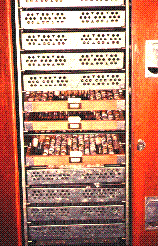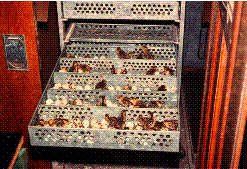Pre-incubation Egg Care:
Successful quail propagation begins in the pre-incubation period. Eggs should be collected twice daily and more frequently in hot weather. Special care must be taken in collecting and handling quail eggs for they are thin-shelled, break more easily than chicken eggs. Eggs should be of a uniform size – extreme large or small size eggs has low hatchability. Eggs held for incubation should be kept in a cool, clean, dust-free room at a temperature of 14 + 3ºC (55 + 5ºF) and 70 + 10 percent relative humidity. Eggs should be stored large end up and they should not be held for more than 7 days before being placed in the incubator. Set only clean eggs. Eggs to be incubated should not be washed; if cleaning is required, it should be done with a clean abrasive or sandpaper. The egg is mostly water and quail egg dehydrates more rapidly. Eggs stored in PVC bags may be stored for a longer period of time (14-21 days) and the hatch will be higher than from unpackaged eggs stored as described above.
Natural Incubation:
Although it is possible to incubate quail eggs under a broody hen or bantam, it is not usually practice in Singapore. From behavioral studies, some coturnix hens will sit on their own eggs in a nesting box, but this is not the general rule.
Artificial Incubation:
 Quail eggs can be incubated successfully in any standard size commercial incubators. However, trays must be modified by adding 1.3 cm x 2.5 cm strips of welded wire to the chicken egg tray holders. Special wooden tray can be ordered to suit the size of quail eggs. Be sure to orient the eggs large end up in the setting trays or place flat in a horizontal tray. Quail eggs will hatch successfully if they are placed in an incubator in any position except with the large end down. The incubator should have a fan to provide adequate air circulation because the developing embryos use oxygen and give off carbon dioxide and heat. Little ventilation is needed at the beginning but the requirement increases as incubation progresses. The machine should be equipped to allow automatic turning of all eggs through an angle of 90 at least 4-6 times per 24 hours. Turning regularly is particularly critical in early incubation to prevent the embryos from adhering to the shell membrane. Lack of turning during the first 3 to 4 days will produce some malformed embryos as well as other minor defects. Turning may be discontinued after 14 days.
Quail eggs can be incubated successfully in any standard size commercial incubators. However, trays must be modified by adding 1.3 cm x 2.5 cm strips of welded wire to the chicken egg tray holders. Special wooden tray can be ordered to suit the size of quail eggs. Be sure to orient the eggs large end up in the setting trays or place flat in a horizontal tray. Quail eggs will hatch successfully if they are placed in an incubator in any position except with the large end down. The incubator should have a fan to provide adequate air circulation because the developing embryos use oxygen and give off carbon dioxide and heat. Little ventilation is needed at the beginning but the requirement increases as incubation progresses. The machine should be equipped to allow automatic turning of all eggs through an angle of 90 at least 4-6 times per 24 hours. Turning regularly is particularly critical in early incubation to prevent the embryos from adhering to the shell membrane. Lack of turning during the first 3 to 4 days will produce some malformed embryos as well as other minor defects. Turning may be discontinued after 14 days.
Fan-ventila tion incubators should be set at 37.5 + 0.3 ºC. If the temperature of the incubator exceeds these recommendations many embryos may die. During the hatching period temperature should be lowered 0.5 ºC. A relative humidity of about 60 percent is satisfactory during incubation and should be raised to about 70 percent during the hatching period. The incubation period is 16 1/2 to 17 1/2 days. The duration of incubation may range from 16 to 18 days depending upon temperature, humidity and genetic variability. Some farmers in Singapore transfer the developing eggs to a separate hatcher on 15th day of incubation. It takes 10 hours from pipping to hatch, and an additional 5 hours for drying the chick. Then the quail chicks are ready to be distributed to other farmers or go into the brooder for rearing.
tion incubators should be set at 37.5 + 0.3 ºC. If the temperature of the incubator exceeds these recommendations many embryos may die. During the hatching period temperature should be lowered 0.5 ºC. A relative humidity of about 60 percent is satisfactory during incubation and should be raised to about 70 percent during the hatching period. The incubation period is 16 1/2 to 17 1/2 days. The duration of incubation may range from 16 to 18 days depending upon temperature, humidity and genetic variability. Some farmers in Singapore transfer the developing eggs to a separate hatcher on 15th day of incubation. It takes 10 hours from pipping to hatch, and an additional 5 hours for drying the chick. Then the quail chicks are ready to be distributed to other farmers or go into the brooder for rearing.


